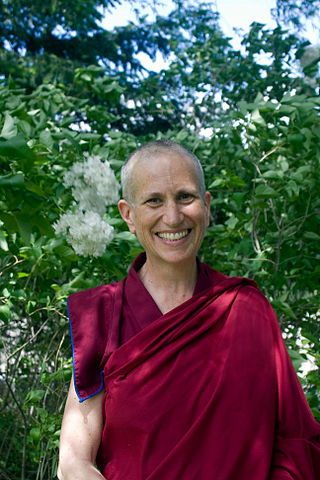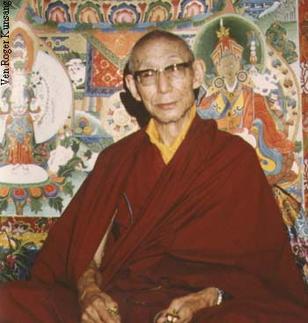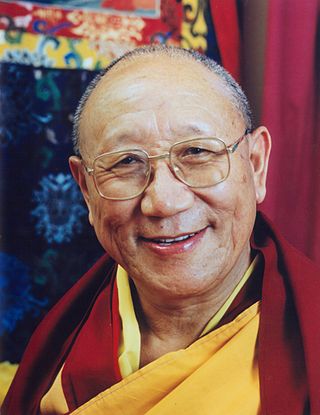
The Gelug is the newest of the four major schools of Tibetan Buddhism. It was founded by Je Tsongkhapa (1357–1419), a Tibetan philosopher, tantric yogi and lama and further expanded and developed by his disciples.
A tulku is a distinctive and significant aspect of Tibetan Buddhism, embodying the concept of enlightened beings taking corporeal forms to continue the lineage of specific teachings. The term "tulku" has its origins in the Tibetan word "sprul sku", which originally referred to an emperor or ruler taking human form on Earth, signifying a divine incarnation. Over time, this term evolved within Tibetan Buddhism to denote the corporeal existence of highly accomplished Buddhist masters whose purpose is to ensure the preservation and transmission of a particular lineage.
There are currently two, separately enthroned 17th Gyalwang Karmapas: Ogyen Trinley Dorje and Trinley Thaye Dorje. The Karmapa is the spiritual leader of the nine-hundred-year-old Karma Kagyu lineage of the Kagyu school of Tibetan Buddhism.

Tashi Paljor, Dilgo Khyentse Rinpoche was a Vajrayana master, scholar, poet, teacher, and recognized by Buddhists as one of the greatest realized masters. Head of the Nyingma school of Tibetan Buddhism from 1988 to 1991, he is also considered an eminent proponent of the Rime tradition.

An international, loosely affiliated group of nonprofit, cultural preservation organizations founded at the request of the Dalai Lama, the Tibet House's preserve, present, and protect Tibet's ancient traditions of philosophy, mind science, art, and culture due to the Chinese invasion of Tibet in 1950 and subsequent Tibetan diaspora. The first Tibet House was founded in New Delhi, India in 1965.

Pabongkhapa Déchen Nyingpo was a Gelug lama of the modern era of Tibetan Buddhism. He attained his Geshe degree at Sera Mey Monastic University, Lhasa, and became a teacher in Tibet. He teaches lay-people. Pabongkha was offered the regency of the present Dalai Lama but declined the request because "he strongly disliked political affairs."

Kyabje Dudjom Rinpoche Jigdral Yeshe Dorje was known simply as Dudjom Rinpoche. He is considered by many Tibetan Buddhists to be from an important Tulku lineage of Terton Dudul Dorje (1615-1672), and was recognized as the incarnation of Terton Dudjom Lingpa (1835-1904), a renowned treasure revealer. He was a direct incarnation of both Padmasambhava and Dudjom Lingpa. He was a Nyingma Householder, a yogi, and a Vajrayana and Dzogchen master. According to his secretary Khenpo Tsewang Dongyal and many others, he was revered as "His Holiness" (Kyabje) and as a "Master of Masters".
Shabdrung Lama Kunga Thartse Rinpoche is a Tibetan teacher of the Sakya school of Vajrayana Tibetan Buddhism. Lama Kunga Rinpoche is licensed in California to perform marriages with a Tibetan Buddhist ceremony.

Thubten Chodron, born Cheryl Greene, is an American Tibetan Buddhist nun, author, teacher, and the founder and abbess of Sravasti Abbey, the only Tibetan Buddhist training monastery for Western nuns and monks in the United States. Chodron is a central figure in the reinstatement of the Bhikshuni ordination of women. She is a student of the 14th Dalai Lama, Tsenzhab Serkong Rinpoche, Lama Thubten Yeshe, Thubten Zopa Rinpoche, and other Tibetan masters. She has published many books on Buddhist philosophy and meditation, and is co-authoring with the Dalai Lama a multi-volume series of teachings on the Buddhist path, The Library of Wisdom and Compassion.
Khunu Lama Tenzin Gyaltsen, 1894–1977, known also as Negi Lama Tenzin Gyaltsen, Tenzin Gyaltsen, and various other names like Kunu Rinpoche, Kunu Lama and Negi Lama, was born in 1894 in the village of Sunam which lies in the Kinnaur district of India in the western Himalayas. He passed away at the age of 82 at Shashur Monastery in the Lahaul and Spiti district of Himachel Pradesh on February 23, 1977, while teaching the final page of Gampopa's Jewel Ornament of Liberation. Khunu Rinpoche was not officially recognized as a tulku, nor was he an ordained Buddhist monk, but a layman who had taken lay practitioner's vows before becoming a Tibetan Buddhist master.
Kyabje Trijang Chocktrul Rinpoche is the current tulku of the third Trijang Rinpoche, and succeeded Trijang Lobsang Yeshe Tenzin Gyatso. Rinpoche is the current principal throne holder of Shar Gaden Monastic University in South India, Karnataka, and the spiritual director of the Trijang Buddhist Institute in Northfield, Vermont.
Khensur Denma Locho Rinpoche also known as Lobsang Oser Choying Gyatso, was a Tibetan incarnate lama, or tulku, of the Loseling College of Drepung Monastery. An expert on Yamantaka and Vajrayogini, he is considered an incomparable luminary of Je Tsongkhapa's lineage, is renowned as a holder of the Tantric lineages, a master of the Tantric yogas, and the lineage holder of Ling Rinpoche.
Loden Sherab Dagyab Rinpoche was born on July 27, 1940, in Menya, East Tibet. He was recognized as the reincarnation of the 9th Kyabgoen at the age of four. The Dagyab Kyabgoens have been the spiritual heads of the Dagyab region in Eastern Tibet, and carry the title Hothogthu Nomonhan. 'Hothogthu’ means noble, ‘Nomonhan’ refers to the King of Dharma. This title is exclusive to a small group of the most outstanding and highest-ranking incarnate Lamas, often reincarnations of Regents of Tibet. Dagyab Rinpoche is the only Hothogthu living in the west. The lineage of the Kyabgoens, “Lords of Protection” of the Dagyab region of Tibet, goes back to Dragpa Gyatso.

Kyabje Yongzin Ling Rinpoche is a Tibetan tulku. The best-known incarnation is the sixth incarnation, Thupten Lungtok Namgyal Thinley, a Tibetan buddhist scholar and teacher.

The Third Trijang Rinpoche, Lobsang Yeshe Tenzin Gyatso (1901–1981) was a Gelugpa Lama and a direct disciple of Pabongkhapa Déchen Nyingpo. He succeeded Ling Rinpoche as the junior tutor of the 14th Dalai Lama when the Dalai Lama was nineteen years old. He was also a lama of many Gelug lamas who taught in the West including Zong Rinpoche, Geshe Rabten, Lama Yeshe, Kelsang Gyatso, and Lama Zopa Rinpoche. Trijang Rinpoche's oral teachings were recorded by Zimey Rinpoche in a book called the Yellow Book.

(Kyabje) Choden Rinpoche was a contemporary yogi-scholar of the Gelugpa school of Tibetan Buddhism and a reincarnation ('sprul-sku') of the Choden lineage, the historical abbots of Rabten Monastery (Tibetan: རབ་བརྟེན་དགོན་པ, Wylie: in Rong-bo district, Kham.

Khyongla Rato, pronounced "Chungla," was also known as Khyongla Rato Rinpoche, Rato Khyongla Rinpoche, Khyongla Rinpoche, Ngawang Lobsang Shedrub Tenpai Dronme, and Nawang Losang, his monk's name. Born in Dagyab county in Kham province in southeastern Tibet, he was recognized as an incarnate lama at an early age. He spent over 30 years receiving teachings and studying as a highly trained monk in the Tibetan Buddhist monasteries of Tibet. A respected scholar, he was a debate partner of the 14th Dalai Lama at his Geshe examination in Lhasa, Tibet. He founded the Tibet Center in New York City. The center co-sponsored many of the Dalai Lama's teachings in New York City.

Dzogchen Ranyak Patrul Rinpoche is a Tibetan lama, teacher, and author in the Nyingma school of Tibetan Buddhism. He is the founder of the Dzogchen Centre Belgium, a branch of the Dzogchen Monastery in Tibet.

Kyabje Khensur Kangurwa Lobsang Thubten Rinpoche, was a Buddhist monk, Abbot of Sera Jey Monastery, and the founder of Tibetan Buddhist Institute (Adelaide). Khensur means "former abbot" and Rinpoche means "precious teacher."

Tibet House US (THUS) is a Tibetan cultural preservation and education 501(c)(3) nonprofit founded in 1987 in New York City by a group of Westerners after the Fourteenth Dalai Lama, Tenzin Gyatso, expressed his wish to establish a cultural institution to build awareness of Tibetan culture.













